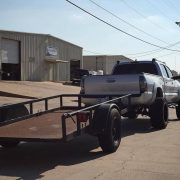Home » Product Guides » Toyota Tacoma Off Road Mods That Do Work + Overland Accessories
Toyota Tacoma Off Road Mods That Do Work + Overland Accessories
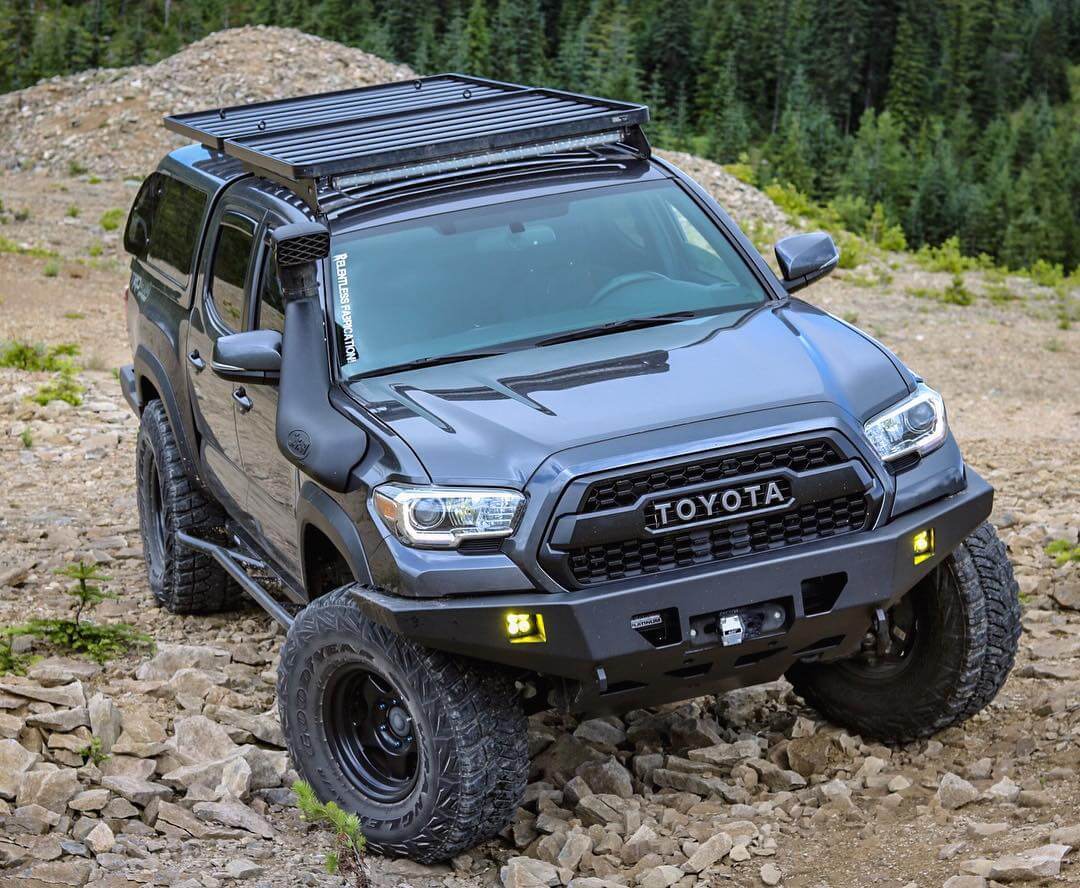
The Toyota Tacoma is a truck that’s built for adventure, and it’s incredibly capable right out of the box. If you’re looking to take your Tacoma off the beaten path, you may only need a few small modifications to make it go anywhere.
Over the years, we’ve featured various Tacomas on Offroadium, and we’ve seen firsthand which modifications have proven to be the most effective. In this article, we’ve compiled a list of the top Toyota Tacoma off-road mods that actually work, based on the experiences of Tacoma owners and accessories that will make your wheeling more safe and comfortable for you.
Affiliate disclosure: we may earn a small commission at no additional cost to you if you buy through some of the product links in this post.
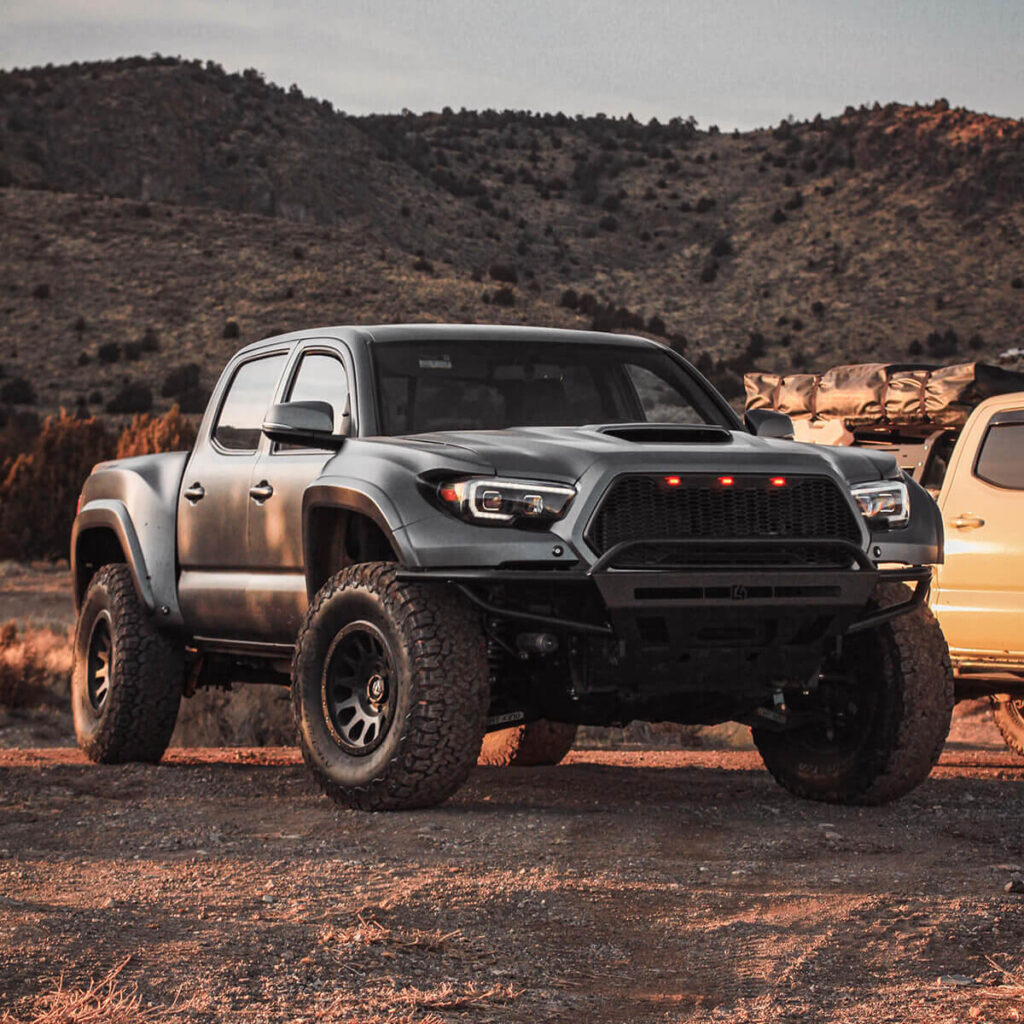
Table of Contents
ToggleThe Off road Mods

Tires
It really comes down to the question of where you want to go and how much you want to risk (yeah, just like in the Coldplay song). So you may only need bigger off-road tires with extra grip that will improve traction on sand, dirt, snow, or whatever path you choose.
4 out of 4 3rd gen Tacoma trucks we have featured on Offroadium are equipped with oversized All-Terrain or Mud-Terrain tires – so it’s a common practice. For 33″s you may not even need a lift.
We have an article dedicated to Tacoma off-road tires, check it our for more info.
Based on what has been used on the builds that we’ve featured on Offroadium we can recommend the following tires:
- 32″ BF Goodrich T/A KO2 275/70R17 for stock suspension (Vehicle 1)
- 33″ Nitto Ridge Grappler Tires with a lift (Vehicle 2 )
- 35″ Goodyear Wrangler MTR tires 315/75R16 (Vehicle 4)
- 35×12.5R17 BF Goodrich T/A KO2 tires with a long travel kit (Vehicle 3)
Pros:
- Unquestionably improve the off-road capabilities (traction and additional ground clearance if the size is bigger than factory recommended.
- Awesome looks
Cons:
- Bigger tires affect the gas mileage
- Slower acceleration (unless you regear)
- May be expensive, especially if bought together with a new set of rims
Alternatives:
- While nothing really can substitute the off-road tires, you can take advantage of the tire chains in some situations. It’s a shortcut or a cheat that’s often overlooked, but it does work.
- Traction boards – while they work better with A/T or M/T tires, you can benefit from them even on your stock road tires.
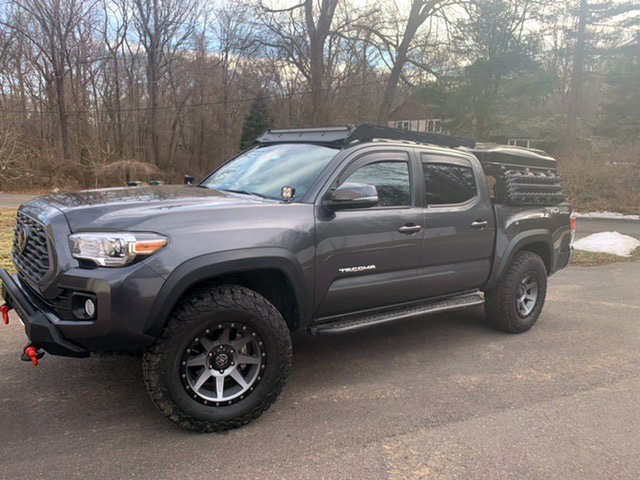
Lift
If the tires you want to install on your Tacoma wouldn’t fit on the stock suspension, a lift would free up the space in the wheel wells and give a few inches of the ground clearance.
3 out of 4 Tacoma builds we have featured on Offroadium are equipped with a lift.
Based on what has been used on the builds that we’ve featured on Offroadium we can recommend the following suspension lifts:
Pros:
- Extra ground clearance
- More wheel travel
- Improved suspension damping
Cons:
- Shifts the center of mass higher, making the truck less stable on the road
- Affects handling
- Increased wear on components
- Price
Alternatives:
- Choose biggest tire size that doesn’t require a lift and keep the suspension stock(cutting may be required if the wheels rub)
If your truck came with 30″ tires and you install 32″ tires, you gain 1″ of ground clearance improvement on the stock suspension. However, your wheel travel is limited, and rubbing will most likely occur when the suspension is compressed. This issue may be addressed with extensive cutting, as shown in the example of this Chevy Colorado build fitted with 37″ tires on a stock suspension, but that’s not a common practice.
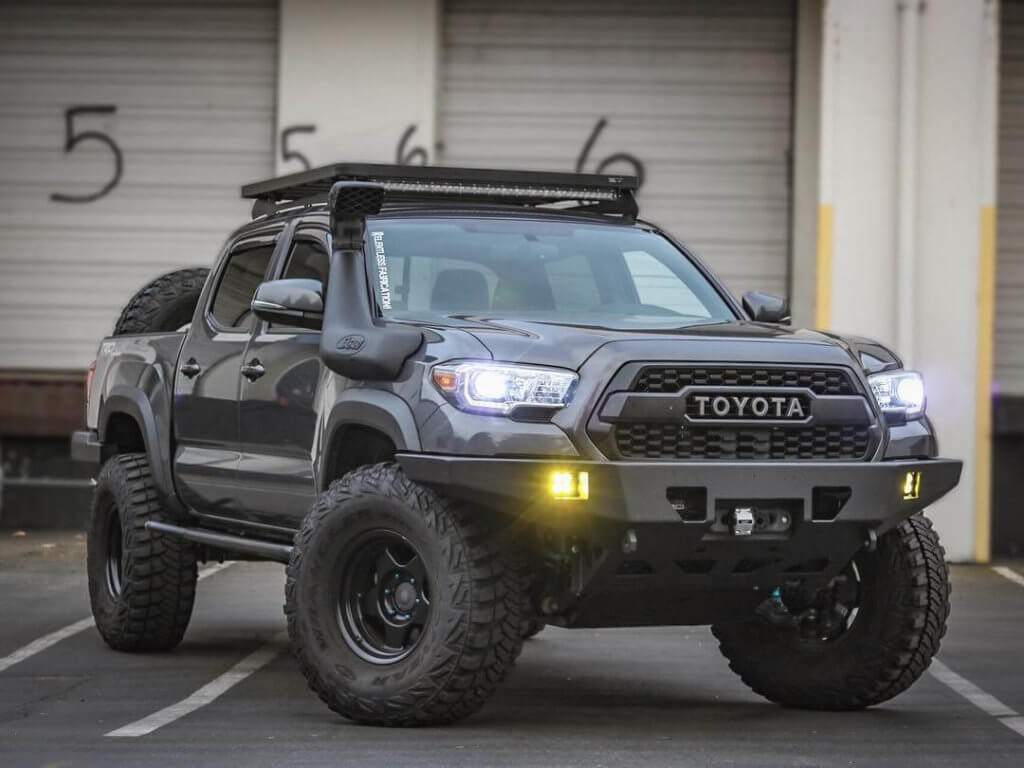
Body Armor
When venturing off-road, protecting your Tacoma from rocks, stumps, and other obstacles is crucial. That’s where body armor comes in. Many Tacoma owners opt for skid plates, rock sliders, and bumpers to safeguard their vehicle’s underbody and sides.
Among the featured builds, we’ve seen a variety of armor solutions:
- Victory 4×4 Front and Mid Skid Plates (Vehicle 1)
- Cali Raised Rock Sliders (Vehicle 2)
- Body Armor Bumper (Vehicle 2)
- C4 Fabrications Front Bumper, widened to match the widebody kit (Vehicle 3)
- Relentless Fabrication Body Armor, including front bumper, guards, and rear bumper with a swing-away full-size spare tire carrier (Vehicle 4)
Pros:
- Protects vulnerable components like the oil pan, transmission, and transfer case
- Prevents body damage from rocks, trees, and other trail hazards
- Enhances the truck’s off-road appearance
- Bumpers can improve approach and departure angles
Cons:
- Adds weight to the vehicle, potentially affecting performance and fuel economy
- Can be expensive, especially for comprehensive armor kits
- May require modifications to the vehicle’s body or frame for installation
Alternatives:
- For those on a budget, a combination of careful driving and cheaper, universal skid plates can provide some protection
- Investing in high-quality, durable tires can help prevent punctures and reduce the likelihood of getting stuck, minimizing the need for body armor
Ultimately, the level of protection you choose depends on the type of terrain you plan to tackle and your willingness to accept the risk of damage to your Tacoma.
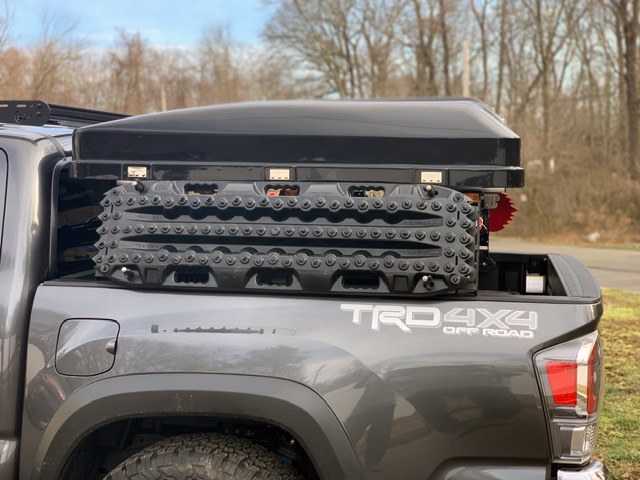
Recovery
Even the most skilled off-roaders can find themselves in situations where recovery gear is necessary. Winches, air compressors, and traction boards are essential tools that can help you overcome obstacles and get back on the trail.
Winches:
Air Compressors:
- ARB Twin Air Compressor with 1-gallon Tank (Vehicle 4)
Traction Boards:
- While not specifically mentioned in the featured builds, traction boards are a valuable recovery tool that can provide additional traction in soft or slippery terrain.
Pros:
- Winches can help pull your vehicle out of mud, sand, or other challenging situations
- Air compressors allow for quick tire pressure adjustments to suit different terrains and can power air tools for repairs
- Traction boards can be used to bridge gaps, provide traction on slippery surfaces, and support the vehicle’s weight in soft terrain
- Having recovery gear can provide peace of mind and self-reliance when off-roading in remote areas
Cons:
- High-quality winches and air compressors can be expensive
- Winches add significant weight to the front of the vehicle, and require a special mounting point
Alternatives:
- Your buddy in a support rig, who can tow you out
- A high lift jack, tire chains or even a hand winch
- Portable air compressors that plug into the vehicle’s 12V outlet
When selecting recovery gear for your Tacoma, consider factors such as the weight of your vehicle, the type of terrain you typically encounter, and your budget. Always prioritize safety and proper use of recovery equipment to minimize the risk of injury or damage.
Overland Gear & Accessories
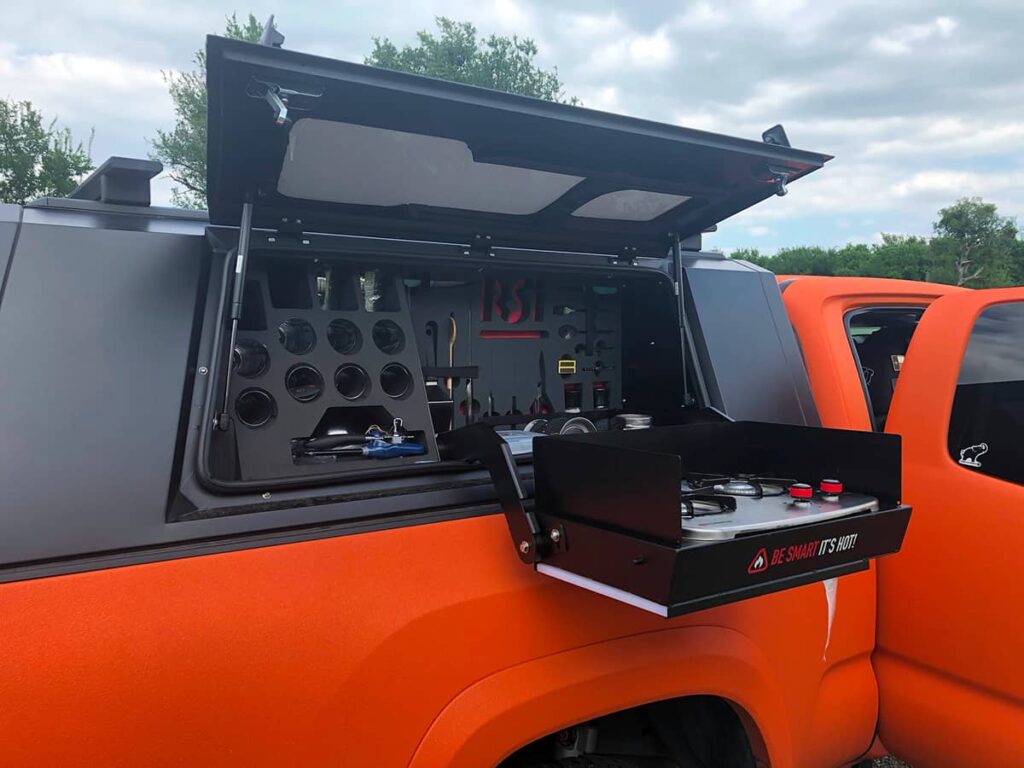
Storage Solutions
When heading out on an off-road adventure, having the right storage solutions can make all the difference in terms of organization, convenience, and maximizing your Tacoma’s cargo capacity. The featured builds showcase a range of storage options to suit different needs and preferences.
Bed Racks:
- KB Voodoo Fabrications Bed Rack (Vehicle 1)
- Uptop Bed Rack (Vehicle 2)
Roof Racks:
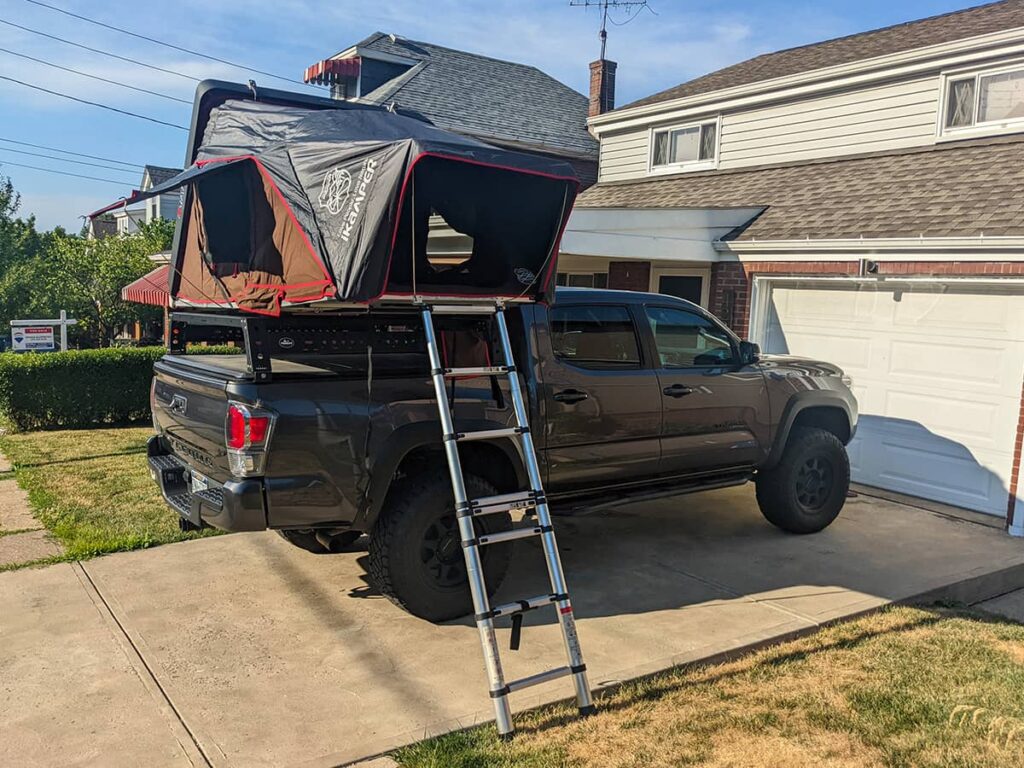
Other:
- Decked Storage Drawer System (Vehicle 2)
- SnugTop Super Sport Camper Shell (Vehicle 4)
- Front Runner Outfitters Fridge Slide (Vehicle 4)
Pros:
- Increases storage capacity without sacrificing interior space
- Allows for easy organization and access to gear
- Provides a secure platform for mounting accessories like tents, awnings, and recovery gear
- Can improve the vehicle’s overall functionality and versatility
Cons:
- Adds weight and potentially affects center of gravity, especially with heavier items stored on the roof
- May increase wind noise and slightly impact fuel economy
- Can be costly, particularly for high-end, custom-fitted solutions
Alternatives:
- For smaller loads, interior storage solutions like seat organizers, center console trays, and rear seat delete kits can be effective
- Soft-sided storage bags and containers can be a budget-friendly option for organizing gear in the bed or cabin
- Trailer hitches and tow-behind cargo carriers offer additional storage space without affecting the vehicle’s weight distribution or aerodynamics
Choose the storage solutions that best fit your specific needs, budget, and the type of gear you typically bring on your off-road adventures. There’s no need to even buy a roof rack (like on the Instagram builds) if the stuff you usually carry fits on the rear seats or inside the bed.
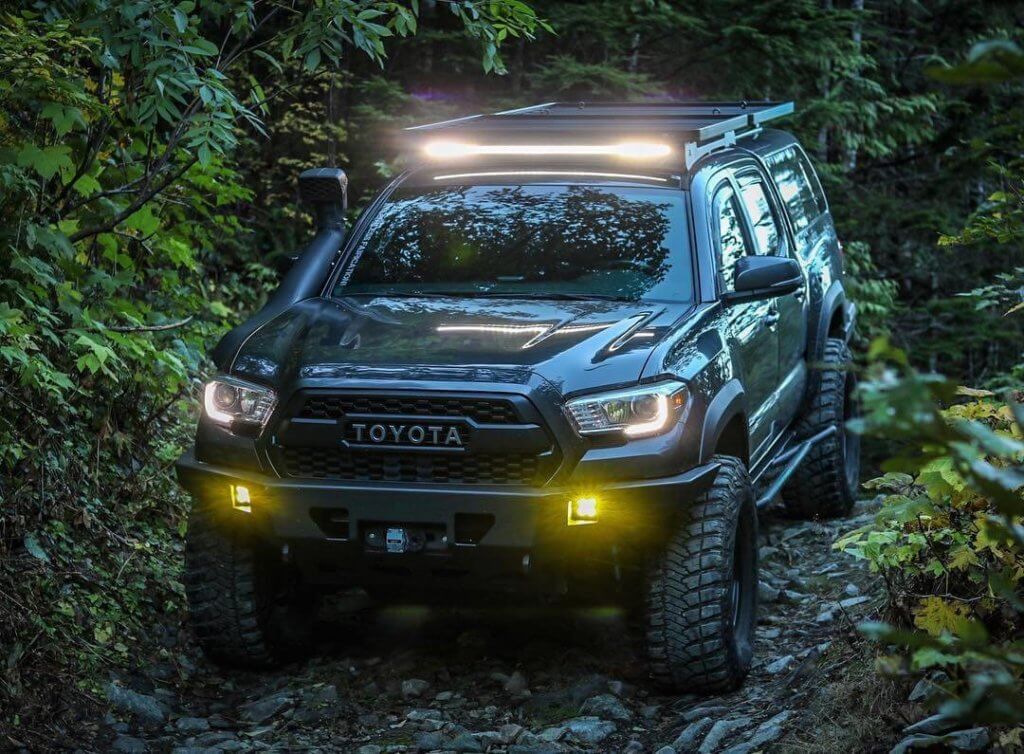
Lighting
Upgrading your Tacoma’s lighting is not only beneficial for nighttime off-road adventures but also enhances visibility and safety on the trail. The featured builds incorporate various lighting enhancements to suit different preferences and budgets.
LED Light Bars:
- Rough Country 20″ Light Bar (Vehicle 2)
- Cali Raised 40″ Light Bar (Vehicle 2)
- 15″ Fog Light Bar (Vehicle 2)
Headlights and Fog Lights:
- Spyder Auto DRL Projector Headlights (Vehicle 3)
- Baja Design Squadron lights (Vehicle 2)
Other:
- LED Interior Lights (Vehicle 2)
Pros:
- Improves visibility on the trail, especially during nighttime off-roading
- Enhances safety by increasing the driver’s awareness of obstacles and terrain
- Can provide a wider and farther-reaching light pattern compared to stock lighting
- Allows for customization to suit personal preferences and specific off-road needs
Cons:
- High-output lighting can be expensive, particularly for premium brands and larger light bars
- Improper installation or aiming can cause glare and reflections, potentially affecting other drivers
- Increased power draw may require upgrades to the vehicle’s electrical system
Alternatives:
- Upgrading to high-performance halogen bulbs can be a cost-effective way to improve light output without requiring extensive modifications
- Auxiliary lighting pods or cubes can provide targeted illumination for specific areas, such as wheel wells or the rear of the vehicle
- Handheld or mountable spotlights offer flexibility and can be used as needed without permanent installation
When selecting lighting upgrades for your Tacoma, consider factors such as beam pattern, light color temperature, and power consumption to ensure optimal performance and compatibility with your vehicle and off-road needs.
Conclusion
In conclusion, the Toyota Tacoma is a highly capable off-road vehicle even in the stock form, so you may not need anything but the new tires to go off-roading in it. Yet, to make it more capable and comfortable, consider the mods and accessories we covered above.
From essential upgrades like suspension lifts, and body armor to convenient additions such as storage solutions and lighting improvements, there are numerous ways to customize your Tacoma for your specific off-road needs.
Matt is a professional mechanic, experienced off-roader, writer and founder of Offroadium. With over 15 years immersed in the off-road community and 100,000+ miles logged on rugged trails across the Americas, Grabli shares extensive real-world knowledge. He previously worked as an automotive technician before shifting focus to specialty off-road projects. His passion is prepping capable rigs for off-roading and helping others to build the 4x4s of their dreams.

